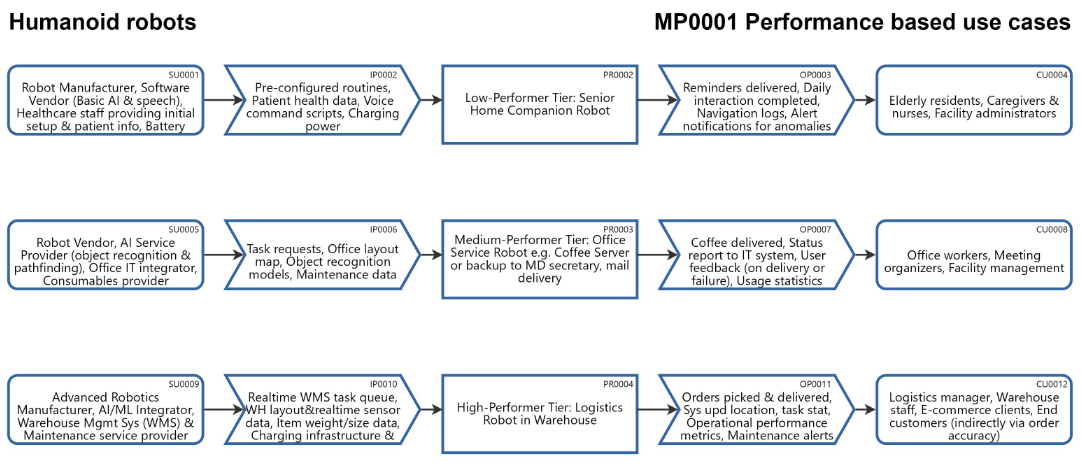Humanoid robot performance based use cases

As humanoid robots evolve, we might see tiered performance levels tailored to different use cases, each with distinct acquisition and operating costs. Just like cars, computers, or smartphones, robots will segment into market categories.
Low-Performer Tier
Use case: Environments requiring safe, predictable, low-speed interaction as e.g. senior homes, reception desks, companionship
- Traits: Slow movement, low force, basic navigation, simple speech/gesture recognition
- Cost: Low to moderate
- Pros: Safe, affordable, low energy use
- Example Tasks:
- Escorting a senior from room to dining hall
- Reminding patients to take medication
- Light cleaning or companionship interaction
- Hardware: Limited sensors, plastic joints, moderate battery life
Medium-Performer Tier
Use case: Light commercial or semi-structured service environments as e.g. office delivery, retail, coffee service
- Traits: Faster movement, better localization/navigation, object handling
- Cost: Medium to high
- Pros: More adaptive, moderate task complexity
- Example Tasks
- Serving coffee or water at meetings
- Navigating a small office to deliver documents
- Providing product information in a store
- Hardware: Lidar, better grippers, improved speech and vision systems
High-Performer Tier
Use case: Dynamic or critical environments as e.g. logistics, manufacturing, disaster response, high-end concierge
- Traits: Precision manipulation, fast walking/running, lifting objects, obstacle avoidance, adaptive AI
- Cost: High to very high (hundreds of thousands to millions of dollars)
- Pros: High agility, strength, autonomy
- Example Tasks:
- Restocking shelves or moving crates in warehouses
- Assisting in construction or inspection
- High-touch concierge roles in luxury settings
- Emergency search-and-rescue or hazardous environment inspection
Hardware: Advanced motors, tactile sensors, full-body motion planning, onboard GPUs
And with increasing capabilities, there will be good and bad humanoid robots.
What drives this stratification?
- Hardware Cost: Precision actuators, sensors, and compute units raise the cost rapidly
- Safety Requirements: Higher-tier robots require more fail-safes
- Battery Life & Energy Efficiency: Lower-tier bots can use less sophisticated power systems
- AI Capability: Better reasoning and perception dramatically increase complexity and price
Like with cars (from a basic city car to a Formula 1 racer), the environment, safety demands, and task complexity will drive the level of performance needed and how much you’re willing to pay for it. The result will be robot classes designed with specific trade-offs in mind, making robotics more accessible and economically viable across industries.
Using the following link you can access this sandbox SIPOC model in the ProcessHorizon web app and adapt it to your needs (easy customizing) and export or print the automagically created visual AllinOne SIPOC map as a PDF document or share it with your peers: https://app.processhorizon.com/enterprises/bP25zgRMTBKxYBcqqLrZT5H2/frontend

